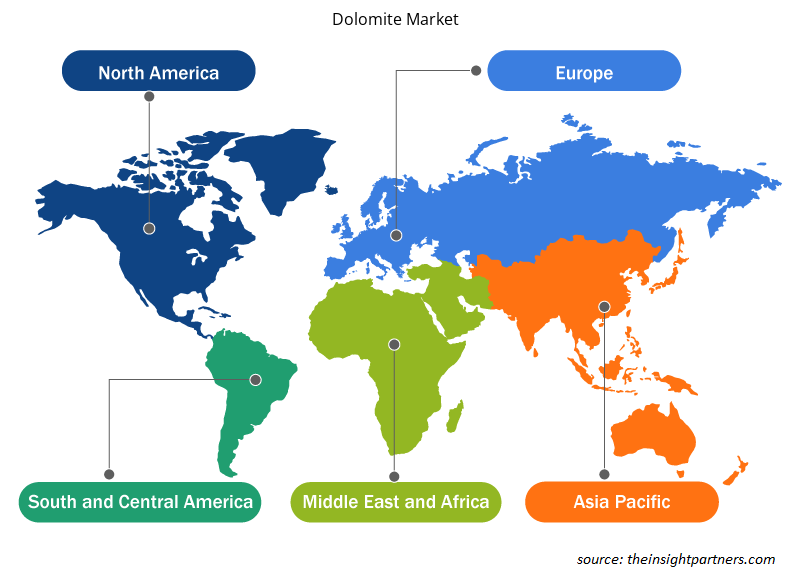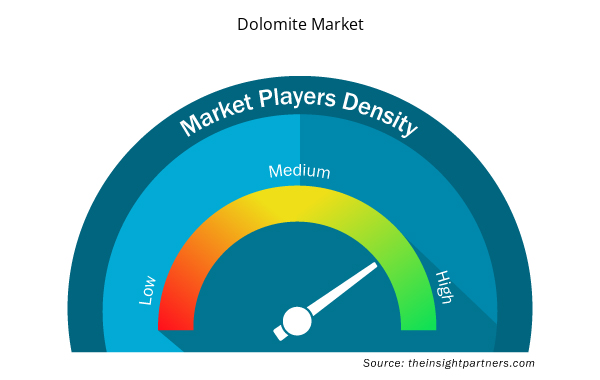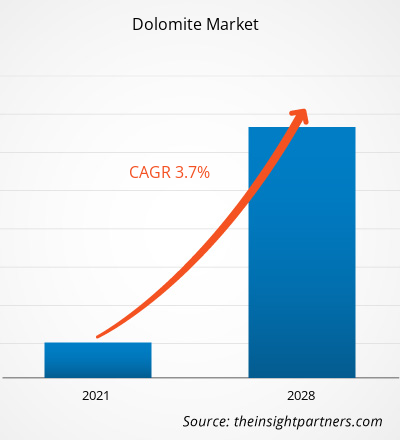Der Dolomitmarkt soll von 21.727,97 Millionen US-Dollar im Jahr 2020 auf 28.558,14 Millionen US-Dollar im Jahr 2028 wachsen; für den Zeitraum 2021–2028 wird eine durchschnittliche jährliche Wachstumsrate (CAGR) von 3,7 % erwartet.
Dolomit ist ein wichtiges Material für die Ferrolegierungsindustrie und wird häufig in Eisen- und Stahlwerken verwendet. Aufgrund seiner Fähigkeit, als Bodenverbesserer zu wirken und den pH-Wert des Bodens auszugleichen, findet es auch in der Landwirtschaft wichtige Anwendung. Öl und Gas, Chemikalien, Gummi, Bergbau und Metalle, Wasseraufbereitung, Pharmazeutika und Kosmetika sind weitere wichtige Endverbraucher dieser Substanz. Da diese Branchen ein beträchtliches Wachstum verzeichnen, insbesondere in Entwicklungsländern, wächst auch die Nachfrage nach Dolomit kontinuierlich. Die negativen Auswirkungen der Bergbauaktivitäten auf die Umwelt bleiben jedoch für die Dolomitproduzenten ein Problem.
Im Jahr 2020 hatte der asiatisch-pazifische Raum den größten Umsatzanteil am globalen Dolomitmarkt . Das schnelle Wachstum der Industrialisierung treibt Investitionen in die Verkehrsinfrastruktur dieser Region voran. Darüber hinaus treibt ein Anstieg der Feuerfestproduktion die Nachfrage nach Dolomit in der Eisen- und Stahlindustrie im asiatisch-pazifischen Raum an. Die Region beherbergt die größten Volkswirtschaften wie China und Indien, die zu den weltweit größten Verbrauchern von Feuerfestmaterialien gehören. China ist einer der größten Stahlproduzenten der Welt, während Indien ein exponentielles Wachstum seiner Infrastruktur erlebt. Diese Faktoren bieten den Akteuren auf dem Dolomitmarkt in der Region zahlreiche Wachstumschancen.
Passen Sie diesen Bericht Ihren Anforderungen an
Sie erhalten kostenlos individuelle Anpassungen an jedem Bericht, einschließlich Teilen dieses Berichts oder einer Analyse auf Länderebene, eines Excel-Datenpakets sowie tolle Angebote und Rabatte für Start-ups und Universitäten.
- Holen Sie sich die wichtigsten Markttrends aus diesem Bericht.Dieses KOSTENLOSE Beispiel umfasst eine Datenanalyse von Markttrends bis hin zu Schätzungen und Prognosen.
Auswirkungen der COVID-19-Pandemie auf den Dolomitmarkt
Die anhaltende COVID-19-Pandemie hat den Status des Chemie- und Materialsektors drastisch verändert und sich negativ auf das Wachstum des Dolomitbergbaumarktes ausgewirkt. Die Umsetzung von Maßnahmen zur Bekämpfung der Ausbreitung von SARS-CoV-2 hat die Situation verschärft. Branchen wie das Baugewerbe sowie die Eisen- und Stahlindustrie sind von der plötzlichen Verzerrung der Betriebseffizienz und den Störungen der Wertschöpfungsketten betroffen, die auf die plötzliche Schließung nationaler und internationaler Grenzen zurückzuführen sind. Ein erheblicher Rückgang des Wachstums der verschiedenen Industriezweige hat zu einer geringeren Nachfrage nach Dolomit geführt. Die Schließung des Bergbaubetriebs hat zu einer beeinträchtigten jährlichen Produktionsleistung geführt. Die langfristigen Auswirkungen der COVID-19-Pandemie auf die Bergbauindustrie werden von der Länge der Sperrzeiten und der Fähigkeit der Akteure der Branche abhängen, wieder aufzuleben. Da viele Länder planen, ihren Betrieb wieder aufzunehmen, wird erwartet, dass die Nachfrage nach Dolomit in den kommenden Monaten weltweit steigen wird. Die Akteure des Dolomitbergbaumarktes konzentrieren sich auf die Verfügbarkeit von Lieferungen und Arbeitskräften, um das volle Betriebsniveau zu erreichen.
Markteinblicke
Breites Anwendungsspektrum von Dolomit fördert Wachstum auf dem Dolomitmarkt
Dolomit hat ein breites Anwendungsspektrum in Endverbraucherbranchen wie Bauwesen, Eisen und Stahl, Ferrolegierungen, Keramik und Glas, Landwirtschaft und Tierfutter. Seine Vorliebe und Verwendung in der Industrie hängt von der Qualität des Gesteins ab. Aufgrund seiner Härte und Dichte ist Dolomit ein häufig verwendeter Stoff in der Bauindustrie. In der Eisen- und Stahlindustrie wird Dolomit in drei Formen verwendet: Rohdolomit, kalzinierter Dolomit und gesinterter Dolomit. Dolomit wird in der chemischen Industrie zur Säureneutralisierung und bei Flussrenaturierungsprojekten verwendet. Außerdem dient er als Magnesia-Quelle (MgO), einem Futterzusatz für Nutztiere. Dolomit wird bei der Herstellung von Autoglas, Bauglas, Fiberglas usw. verwendet. Mit dem Wachstum verschiedener Endverbraucherbranchen wie Bauwesen, Eisen und Stahl sowie Keramik und Glas steigt also auch die Nachfrage nach Dolomit.
Einblicke in die Endverbraucherbranche
Basierend auf der Endverbrauchsindustrie ist der globale Dolomitmarkt in Landwirtschaft, Tierfutter, Keramik und Glas, Eisen und Stahl, Bauwesen und andere unterteilt. Das Segment Eisen und Stahl hatte im Jahr 2020 den größten Marktanteil. Die Eisen- und Stahlindustrie wird stark vom Wachstum von Segmenten wie Verteidigung, Schwermaschinenbau, Energie und Bauwesen getrieben. Die ständig steigende Nachfrage aus diesen Sektoren aufgrund der raschen Urbanisierung und Industrialisierung, insbesondere in Entwicklungsregionen wie dem asiatisch-pazifischen Raum sowie Süd- und Mittelamerika, ist ein wichtiger Faktor, der zur hohen Nachfrage nach Dolomit in der Welt beiträgt, was das Marktwachstum ankurbelt.
Einige der wichtigsten Marktteilnehmer auf dem globalen Dolomitmarkt sind Beihai Group, Calcinor, Essel Mining & Industries Limited, JFE GROUP, INCA MINING, LHOIST GROUP, Sibelco, RHI Magnesita GmbH, Arihant Min chem und Omya AG.
Regionale Einblicke in den Dolomitmarkt
Die regionalen Trends und Faktoren, die den Dolomitmarkt während des Prognosezeitraums beeinflussen, wurden von den Analysten von Insight Partners ausführlich erläutert. In diesem Abschnitt werden auch die Dolomitmarktsegmente und die Geografie in Nordamerika, Europa, im asiatisch-pazifischen Raum, im Nahen Osten und Afrika sowie in Süd- und Mittelamerika erörtert.

- Holen Sie sich die regionalspezifischen Daten für den Dolomitmarkt
Umfang des Dolomit-Marktberichts
| Berichtsattribut | Details |
|---|---|
| Marktgröße im Jahr 2020 | 21,73 Milliarden US-Dollar |
| Marktgröße bis 2028 | 28,56 Milliarden US-Dollar |
| Globale CAGR (2020 - 2028) | 3,7 % |
| Historische Daten | 2018-2019 |
| Prognosezeitraum | 2021-2028 |
| Abgedeckte Segmente | Nach Endverbrauchsbranche
|
| Abgedeckte Regionen und Länder | Nordamerika
|
| Marktführer und wichtige Unternehmensprofile |
|
Dichte der Marktteilnehmer für Dolomit: Deren Auswirkungen auf die Geschäftsdynamik verstehen
Der Dolomitmarkt wächst rasant, angetrieben durch die steigende Endverbrauchernachfrage aufgrund von Faktoren wie sich entwickelnden Verbraucherpräferenzen, technologischen Fortschritten und einem größeren Bewusstsein für die Vorteile des Produkts. Mit steigender Nachfrage erweitern Unternehmen ihr Angebot, entwickeln Innovationen, um die Bedürfnisse der Verbraucher zu erfüllen, und nutzen neue Trends, was das Marktwachstum weiter ankurbelt.
Die Marktteilnehmerdichte bezieht sich auf die Verteilung der Firmen oder Unternehmen, die in einem bestimmten Markt oder einer bestimmten Branche tätig sind. Sie gibt an, wie viele Wettbewerber (Marktteilnehmer) in einem bestimmten Marktraum im Verhältnis zu seiner Größe oder seinem gesamten Marktwert präsent sind.
Die wichtigsten auf dem Dolomitmarkt tätigen Unternehmen sind:
- Beihai-Gruppe
- Calcinor
- Essel Mining & Industries Limited
- JFE-Gruppe
- INKA-BERGBAU
Haftungsausschluss : Die oben aufgeführten Unternehmen sind nicht in einer bestimmten Reihenfolge aufgeführt.

- Überblick über die wichtigsten Akteure auf dem Dolomite-Markt
Bericht-Spotlights
- Fortschrittliche Branchentrends auf dem Dolomitmarkt helfen den Akteuren bei der Entwicklung wirksamer langfristiger Strategien
- In Industrie- und Entwicklungsländern angewandte Strategien für Unternehmenswachstum
- Quantitative Analyse des Dolomitmarktes von 2019 bis 2028
- Schätzung der weltweiten Nachfrage nach Dolomit
- Porters Fünf-Kräfte-Analyse zur Veranschaulichung der Wirksamkeit von Käufern und Lieferanten in der Branche
- Aktuelle Entwicklungen zum Verständnis des wettbewerbsorientierten Marktszenarios
- Markttrends und -aussichten sowie Faktoren, die das Wachstum des Dolomitmarktes bestimmen
- Unterstützung im Entscheidungsprozess durch Aufzeigen von Marktstrategien, die das kommerzielle Interesse untermauern und zum Marktwachstum führen
- Größe des Dolomitmarktes an verschiedenen Knotenpunkten
- Detaillierte Marktübersicht und -segmentierung sowie die Dynamik der Dolomitindustrie
- Größe des Dolomitmarktes in verschiedenen Regionen mit vielversprechenden Wachstumschancen
Der globale Dolomitmarkt wurde wie folgt segmentiert:
Nach Endverbrauchsbranche
- Landwirtschaft
- Tierfutter
- Keramik und Glas
- Eisen und Stahl
- Konstruktion
- Sonstiges
Firmenprofile
- Beihai-Gruppe
- Calcinor
- Essel Mining & Industries Limited
- JFE-Gruppe
- INKA-BERGBAU
- LHOIST-GRUPPE
- Sibelco
- RHI Magnesita GmbH
- Arihant Min Chemie
- OMV Immobilien AG
- Historische Analyse (2 Jahre), Basisjahr, Prognose (7 Jahre) mit CAGR
- PEST- und SWOT-Analyse
- Marktgröße Wert/Volumen – Global, Regional, Land
- Branche und Wettbewerbsumfeld
- Excel-Datensatz



Report Coverage
Revenue forecast, Company Analysis, Industry landscape, Growth factors, and Trends

Segment Covered
This text is related
to segments covered.

Regional Scope
North America, Europe, Asia Pacific, Middle East & Africa, South & Central America

Country Scope
This text is related
to country scope.
Häufig gestellte Fragen
On the basis of application, construction segment is estimated to register the fastest CAGR in the market over the forecast period. Dolomite is extensively used in the construction sector owing to its hardness and density. Dolomite is utilized for various constructions and building product applications such as asphalt and concrete mixes in a broad variety of building & construction applications such as airport runways, highways, parking lots, curbs, sidewalks, residential streets, roadways, and others. These factors are anticipated to drive the construction segment growth during the projection period.
Wide range of dolomite applications is one of the key drivers for the growth of the global dolomite market. Dolomite has a wide scope of applications in end-user industries such as construction, iron and steel, ferroalloys, ceramics and glass, agriculture, and animal feed. Dolomite is a commonly used substance in the construction industry because of its hardness and density. In the iron and steel industry, dolomite is used in three forms raw dolomite, calcined dolomite, and sintered dolomite. In the iron and steel industry, it is mainly used as a fluxing material for the protection of refractory lining, and as a refractory raw material. Raw dolomite or calcined dolomite is used as a fluxing material. Thus, with the growth of various end-user industries, such as construction, iron and steel, and ceramics and glass, the demand for dolomite is also growing.
China is the leading country of the global dolomite market in Asia Pacific. China is one of the biggest markets for dolomite which is due to the growing refractory production along with the various uses of dolomite in construction and agricultural industry. Manufacturers in China are investing in order to increase the supply of dolomite-based products. Demand for dolomite in China is also increasing which is due to the expansion of crude steel production. Along with this, the increased utilization of dolomite as an aggregator in the construction industry as well as the fertilizer in agriculture industry is driving the growth for dolomite market in China.
Based on application, the iron and steel segment is anticipated to account for the largest share in the global dolomite market. The iron and steel industry is highly driven by the growth of various sectors in such as defense, heavy engineering, energy, and construction. With the ever-increasing demand from these sectors owing to rapid urbanization and industrialization in developing regions such as Asia Pacific, and South and Central America the demand for dolomite is expected to be constantly rise globally.
The major players operating in the global dolomite market are Beihai Group; Calcinor; Essel Mining & Industries Limited; JFE GROUP; INCA MINING; LHOIST GROUP; Sibelco; RHI Magnesita GmbH; Arihant Min chem; Omya AG, and others.
During the forecast period, Asia Pacific is anticipated to account for the largest share in the global dolomite market. Countries in Asia Pacific, such as India, China, Japan, South Korea, and Australia, are witnessing surge in industrialization and urbanization activities. The rapid growth of industrialization is driving investments in transport infrastructure. Further, a rise in refractories production is propelling the demand for dolomite in the iron and steel industries in Asia Pacific. China is a leading producer and consumer of refractories. The growing refractory industry in China, will provide various growth opportunities for the dolomite market players in Asia Pacific.
Trends and growth analysis reports related to Chemicals and Materials : READ MORE..
The List of Companies - Dolomite Market
- Beihai Group
- Calcinor
- Essel Mining & Industries Limited
- JFE GROUP
- INCA MINING
- LHOIST GROUP
- Sibelco
- RHI Magnesita GmbH
- Arihant Min chem
- Omya AG
The Insight Partners performs research in 4 major stages: Data Collection & Secondary Research, Primary Research, Data Analysis and Data Triangulation & Final Review.
- Data Collection and Secondary Research:
As a market research and consulting firm operating from a decade, we have published and advised several client across the globe. First step for any study will start with an assessment of currently available data and insights from existing reports. Further, historical and current market information is collected from Investor Presentations, Annual Reports, SEC Filings, etc., and other information related to company’s performance and market positioning are gathered from Paid Databases (Factiva, Hoovers, and Reuters) and various other publications available in public domain.
Several associations trade associates, technical forums, institutes, societies and organization are accessed to gain technical as well as market related insights through their publications such as research papers, blogs and press releases related to the studies are referred to get cues about the market. Further, white papers, journals, magazines, and other news articles published in last 3 years are scrutinized and analyzed to understand the current market trends.
- Primary Research:
The primarily interview analysis comprise of data obtained from industry participants interview and answers to survey questions gathered by in-house primary team.
For primary research, interviews are conducted with industry experts/CEOs/Marketing Managers/VPs/Subject Matter Experts from both demand and supply side to get a 360-degree view of the market. The primary team conducts several interviews based on the complexity of the markets to understand the various market trends and dynamics which makes research more credible and precise.
A typical research interview fulfils the following functions:
- Provides first-hand information on the market size, market trends, growth trends, competitive landscape, and outlook
- Validates and strengthens in-house secondary research findings
- Develops the analysis team’s expertise and market understanding
Primary research involves email interactions and telephone interviews for each market, category, segment, and sub-segment across geographies. The participants who typically take part in such a process include, but are not limited to:
- Industry participants: VPs, business development managers, market intelligence managers and national sales managers
- Outside experts: Valuation experts, research analysts and key opinion leaders specializing in the electronics and semiconductor industry.
Below is the breakup of our primary respondents by company, designation, and region:

Once we receive the confirmation from primary research sources or primary respondents, we finalize the base year market estimation and forecast the data as per the macroeconomic and microeconomic factors assessed during data collection.
- Data Analysis:
Once data is validated through both secondary as well as primary respondents, we finalize the market estimations by hypothesis formulation and factor analysis at regional and country level.
- Macro-Economic Factor Analysis:
We analyse macroeconomic indicators such the gross domestic product (GDP), increase in the demand for goods and services across industries, technological advancement, regional economic growth, governmental policies, the influence of COVID-19, PEST analysis, and other aspects. This analysis aids in setting benchmarks for various nations/regions and approximating market splits. Additionally, the general trend of the aforementioned components aid in determining the market's development possibilities.
- Country Level Data:
Various factors that are especially aligned to the country are taken into account to determine the market size for a certain area and country, including the presence of vendors, such as headquarters and offices, the country's GDP, demand patterns, and industry growth. To comprehend the market dynamics for the nation, a number of growth variables, inhibitors, application areas, and current market trends are researched. The aforementioned elements aid in determining the country's overall market's growth potential.
- Company Profile:
The “Table of Contents” is formulated by listing and analyzing more than 25 - 30 companies operating in the market ecosystem across geographies. However, we profile only 10 companies as a standard practice in our syndicate reports. These 10 companies comprise leading, emerging, and regional players. Nonetheless, our analysis is not restricted to the 10 listed companies, we also analyze other companies present in the market to develop a holistic view and understand the prevailing trends. The “Company Profiles” section in the report covers key facts, business description, products & services, financial information, SWOT analysis, and key developments. The financial information presented is extracted from the annual reports and official documents of the publicly listed companies. Upon collecting the information for the sections of respective companies, we verify them via various primary sources and then compile the data in respective company profiles. The company level information helps us in deriving the base number as well as in forecasting the market size.
- Developing Base Number:
Aggregation of sales statistics (2020-2022) and macro-economic factor, and other secondary and primary research insights are utilized to arrive at base number and related market shares for 2022. The data gaps are identified in this step and relevant market data is analyzed, collected from paid primary interviews or databases. On finalizing the base year market size, forecasts are developed on the basis of macro-economic, industry and market growth factors and company level analysis.
- Data Triangulation and Final Review:
The market findings and base year market size calculations are validated from supply as well as demand side. Demand side validations are based on macro-economic factor analysis and benchmarks for respective regions and countries. In case of supply side validations, revenues of major companies are estimated (in case not available) based on industry benchmark, approximate number of employees, product portfolio, and primary interviews revenues are gathered. Further revenue from target product/service segment is assessed to avoid overshooting of market statistics. In case of heavy deviations between supply and demand side values, all thes steps are repeated to achieve synchronization.
We follow an iterative model, wherein we share our research findings with Subject Matter Experts (SME’s) and Key Opinion Leaders (KOLs) until consensus view of the market is not formulated – this model negates any drastic deviation in the opinions of experts. Only validated and universally acceptable research findings are quoted in our reports.
We have important check points that we use to validate our research findings – which we call – data triangulation, where we validate the information, we generate from secondary sources with primary interviews and then we re-validate with our internal data bases and Subject matter experts. This comprehensive model enables us to deliver high quality, reliable data in shortest possible time.


 Holen Sie sich ein kostenloses Muster für diesen Bericht
Holen Sie sich ein kostenloses Muster für diesen Bericht